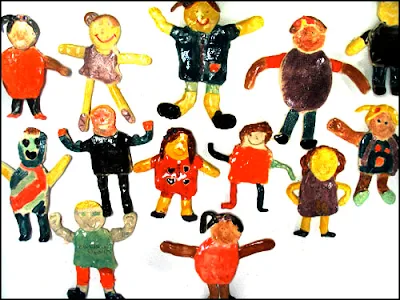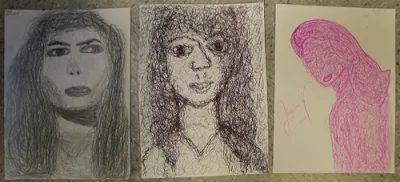(Teacher’s sample design copyrighted 2011 Grimm)
Title: Maori Design
Topic: indigenous cultural design
Goals and Objectives:
- Students will demonstrate how to use designs from alternative cultures to inspire an original artwork assigned to them in class.
- Students will use pattern and a color scheme to create a rhythmic design.
GLEs:
STRAND I: Product/Performance
3. Communicate ideas about subject matter and themes in artworks created for various purposes
A. High School Level I
- Create original artworks using non-objective, architecture and anatomy subject matters.
STRAND IV: Interdisciplinary Connections (IC)
1. Explain connections between visual art and performing arts
A. High School Level I
· Connect meanings of elements in art with terms in music, theatre, or dance
STRAND II: Elements and Principles (EP)
2. Select and use principles of art for their effect in communicating ideas through artwork
D. Rhythm/Repetition: High School Level I
· Identify and use elements to create regular rhythm
STRAND II: Elements and Principles (EP)
2. Select and use principles of art for their effect in communicating ideas through artwork
A. Balance: High School Level I
· Differentiate among and use symmetrical (formal), asymmetrical (informal), and radial balance
STRAND II: Elements and Principles (EP)
1. Select and use elements of art for their effect in communicating ideas through artwork
E. Color: High School Level I
· Identify and use color theory including color value, and color schemes (analogous, monochromatic, and complementary)
STRAND II: Elements and Principles (EP)
1. Select and use elements of art for their effect in communicating ideas through artwork
B. Shapes: High School Level I
· Differentiate between and use geometric and organic (freeform) shapes
STRAND II: Elements and Principles (EP)
1. Select and use elements of art for their effect in communicating ideas through artwork
A. Line: High School Level I
· Identify and use weighted contour, parallel, and perpendicular lines
STRAND III: Artistic Perceptions (AP)
2. Analyze and evaluate art using art vocabulary
A. Art Criticism: High School Level I: With one artwork:
· describe artwork;
- analyze the use of elements and principles in the work;
- Interpret the meaning of the work (subject, theme, symbolism, message communicated);
- Judge the work from various perspectives:
- Showing a real or idealized image of life (Imitationalism)
- Expressing feelings (Emotionalism/ Expressionism)
- Emphasis on elements and principles (Formalism)
- Serving a purpose in the society or culture (Functionalism)
Grade: 9th – 12th
Length of Class Period: 55 minutes
Frequency of Class Period: five days a week
Time Needed: four class periods
Facility & Equipment Requirements:
- One computer lap top
- Room with good lighting
- Large tables, approximately ten, each seating four students
- Two sinks
- Dry erase board
- Drying racks
- Cabinets for storage
- Projector for viewing computer video, CDs and DVDs
Resources Needed:
- Power Point About Maori Design/Symbols
- Maori Symbols worksheet
Materials Per Student:
- White drawing paper and markers
Vocabulary/Terminology:
- Koru – peace, tranquility and personal growth
- Toki –are objects worn by elder Maori that symbolize power and wisdom
- Kowhaiwhai – is the pattern that distinguishes the tribe a particular Maori is from
- Manaia – is a spiritual guardian
- Tiki – a good luck charm and symbolic for fertility
- Roimata – a teardrop that symbolizes comfort
- Hei Matau – a fish hook
- The Circle of Life – represents that life in general has no beginning or ending point that people can prevent from happening. Life and death are inevitable.
- Maori – the indigenous peoples of New Zealand
Motivation- Looking and Talking Activity: Students will watch several youtube videos of the Maori chants used in modern day soccer tournaments and also performed by descendents of the Maori at their national culture center.
Step-by-Step Studio Activity Specifics:
- Students will first view the short films about Maori chants. These films stress the concept of using a cultural practice derivative of one specific group to influence the practices of another. These influences are based in design only and do not require students to produce exact images of that which they do not feel comfortable with or believe in personally.
- Students will then be handed a Maori symbols worksheet and view a Power Point presentation that goes along with it.
- Students will design their own original motif using design elements found in the Maori culture. These elements are spiral in nature and come from the plant life/sea life of their island home.
- Students will need to select one of the following color schemes to illustrate their design ideas: complimentary, split complimentary, neutral, monochromatic, secondary or primary.
- Students will create their final design version using colored felt tip ink pens.
Health & Safety Concerns: There are no health and safety concerns for this project.
Cleanup Time & Strategy: Students will be instructed to put away art materials neatly in their containers, clean off their tables, and recycle their trash two minutes prior to dismissal.
Assessment: A formal assessment/grading rubric sheet is included along with this lesson plan.
All photos and lesson plans copyrighted 2011 Grimm









